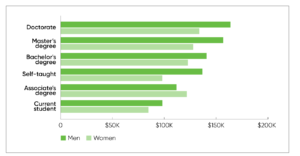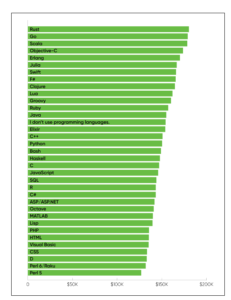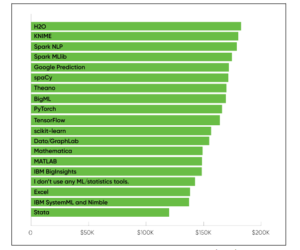
Data and AI Salaries Continue Upward March, O’Reilly Says

(TierneyMJ/Shutterstock)
O’Reilly this week published the results of its salary survey, which showed the average salary for AI and data professionals in the U.S. and the U.K. was $146,000 per year. While that’s certainly more than many jobs, it represents just a 2.25% annual rate of increase on average, according to the survey, which also sliced and diced the salaries by education, job title, gender, state, programming language, and platform.
Among the 3,136 data and AI professionals (ie. data scientists, data engineers, and AI and machine learning specialists) who took O’Reilly’s survey over the Internet in June, those from California earned the most, earning an average of $176,000 per year. That should not be surprising, considering the number of big tech firms who make their home in Silicon Valley, as well as the state’s overall high cost of living. Massachusetts, Delaware, New Jersey, New York, and Maryland followed the Golden State, with average salaries less than $150,000.
Men accounted for 81% of the survey-takers, and they reported average salaries ($150,000) that were significantly higher than that for women ($126,000). Women earned just 84% of what men earned, the survey stated. “That differential held regardless of education,” O’Reilly points out in the survey.
However, despite the salary differential, a higher percentage of women had advanced degrees than men, according to the survey, which shows 16% of women had a doctorate, as opposed to 13% of men. And 47% of women had a master’s degree, as opposed to 46% of men.”

Data and AI professionals’ salaries by gender and education (Source: O’Reilly 2021 Data/AI Salary Survey)
Differences in salaries between the genders were also spotted when viewed through the lens of job title. “At the executive level, the average salary for women was $163,000 versus $205,000 for men (a 20% difference),” O’Reilly says in the report. “At the director level, the difference was much smaller–$180,000 for women versus $184,000 for men–and women’s salaries [at the director level] were actually higher than those at the executive level.”
O’Reilly also gathered data regarding what programming languages the AI and data professionals use. Not surprisingly, the usual suspects were invariably present: Python (used by 61% of respondents), SQL (54%), JavaScript 32%), Bash (29%), Java (24%), and R (20%).
But when the Sebastopol, California-based media company cross-referenced language data with salary data, some interesting trends popped out. For example, the AI and data pros who put a checkmark next to Rust had the highest average salary ($180,000+) out of all the languages. That was followed by Go ($179,000) and Scala ($178,000).
O’Reilly took a stab at explaining it: “The supply of talent for newer languages like Rust and Go is relatively small. While there may not be a huge demand for data scientists who use these languages (yet), there’s clearly some demand—and with experienced Go and Rust programmers in short supply, they command a higher salary,” it stated in the report.

How data and AI professionals’ salaries vary by programming languges (Source: O’Reilly 2021 Data/AI Salary Survey)
Not surprisingly, the most popular languages (Python, SQL, Bash, and R) reverted to the mean when it comes to salaries, with a cluster of them showing up just shy of $150,000, right around absolute median salary in this study. Java showed slightly elevated traction, with an average slightly above $150,000 (just ahead of everybody’s favorite language, “I don’t use programming languages”). Outliers on the downside included Perl, D, and CSS, which clustered around the $125,000/yr. level.
O’Reilly also asked about what tools and platforms AI and data pros use for statistics and machine learning, and this is where the salary comparisons get really interesting. For starters, it’s apparent that the folks who are using these tools are paid slightly higher than the average respondent to this survey; that is, the distribution skews higher than $150,000.
Not surprisingly, some of the most popular statistics and machines tools and platforms, such as PyTorch and TensorFlow, are clustered in the middle, which on this chart is about $155,000. Outliers on the high end include H2O.ai, for which the average user is paid around $175,000, and KNIME, coming in right below that. Spark NLP, SparkMLlib, and Google Prediction round out the top five.
The outliers on the low end is Stata, with an average salary around $115,000 per year. There’s a big jump then to IBM System ML and Nimble (a lightweight deep learning library based on PyTorch) at around $140,000, followed closely by Excel and everybody’s favorite ML/statistic package “I don’t use any ML/statistics tools” right around the median for the whole survey (roughly $145,000).
The salary data around data frameworks was also interesting. Clicktale, a cloud-based analytic service that was acquired by ContentSquare in 2019, led the pack with an average salary of $225,000, followed closely by Tecton, a cloud-based feature store we wrote about earlier this year.
Data and AI pros who reported using Ray, Amundsen, and Apache Kafka had higher-than-average salaries in the $160,000 to $180,000 range. The low man on the framework totem pole was Google Analytics, with a salary just shy of $150,000, which shows that, like those who reported using statistics/ML tools, the folks who use these frameworks are likely more senior data scientists/ML engineers and are more highly compensated.

Data and AI professionals’ salaries by statistics/ML packages (Source: O’Reilly 2021 Data/AI Salary Survey)
The last bit of interesting data relates to training. Folks who reported more than 100 hours of training reported an average salary increase of greater than $11,000. O’Reilly says respondents who took advantage of company-provided training–including certification programs, a tech conference, or some other type of training–had the highest average salaries. The data was similar for those data and AI professionals who obtained certifications.
“Our survey reveals just how dedicated data and AI professionals are to advancing their careers through skill development and training,” stated Mike Loukides, report author and vice president of content at O’Reilly, in a press release. “Getting L&D [learning and development] right is crucial for companies to retain and attract top talent in this hot job market.”
You can read more about the O’Reilly 2021 Data/AI Salary survey, and download the report, at www.oreilly.com/radar/2021-data-ai-salary-survey.
Related Items:
Hiring, Pay for Data Science and Analytics Pros Picks Up Steam
Data Salaries Get a COVID Bump
Why Data Science is Still a Top Job































